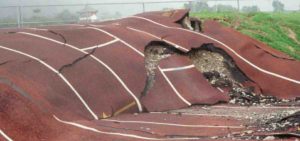
In the past decade scientists have been experimenting with metamaterials, artificial materials designed with periodic internal structures to give them properties not found in natural materials. Depending on their internal geometry and composition, researchers have found that they can control waves propagating through some of these materials, filtering sound or deflecting light so that an object appears “cloaked” or invisible, for instance.
Could this same principle be applied to controlling seismic waves? At the SSA 2019 Annual Meeting, seismologists from around the world will discuss how metamaterial theory might be applied to everything from developing deflective barriers to manipulating the layout of buildings within a city as a way to minimize the impact of damaging surface seismic waves.
Lav Joshi, a Ph.D. student and J. P. Narayan, a professor at the Indian Institute of Technology in Roorkee, India are exploring whether the metamaterial concept can be scaled up to the size of a city. They were inspired by earlier studies where researchers looked at how groups of trees could be used as a natural metamaterial to mitigate the damaging potential of Rayleigh waves, that “roll” across the ground spreading out from the epicentral zone of an earthquake.
“Borrowing ideas from these studies, we started working on the concept of existing structures as metamaterials or metastructures, combining our present knowledge of site-city interaction effects and seismic wave propagation,” said Joshi.
Joshi and colleagues conducted 3-D simulations of how Rayleigh waves pass through the structures of varying heights and widths within a city. They found that the structures act as “resonators” that pluck energy from the Rayleigh waves.
To maximize this effect on a city-wide basis, Joshi said, “the possible arrangement for a city would be that the height of a building should decrease radially inward, as the fundamental longitudinal mode of vibration of high-rise buildings can coincide with the flexural mode of vibration of shorter buildings, causing a significant reduction in their damage.”
Other factors, including features of the surrounding landscape like mountains and valleys, will interact with the pattern of buildings as well, affecting the extent of the damage, he added.
In another presentation at the meeting, Maria Todorovska of Tianjin University in China will present her work on how a periodic arrangement of large-scale barriers such as excavated holes and hills could act as a seismic metamaterial. Her modeling results show that periodic “valleys” appear to reduce more ground motion than deeper and narrower “canyons” or hills.
With more research, the idea of patterning the urban landscape as a seismic metamaterial might aid city planners and earthquake engineers as they build in areas where shallow damaging earthquakes are expected, the scientists say.
Note: The above post is reprinted from materials provided by Seismological Society of America.










